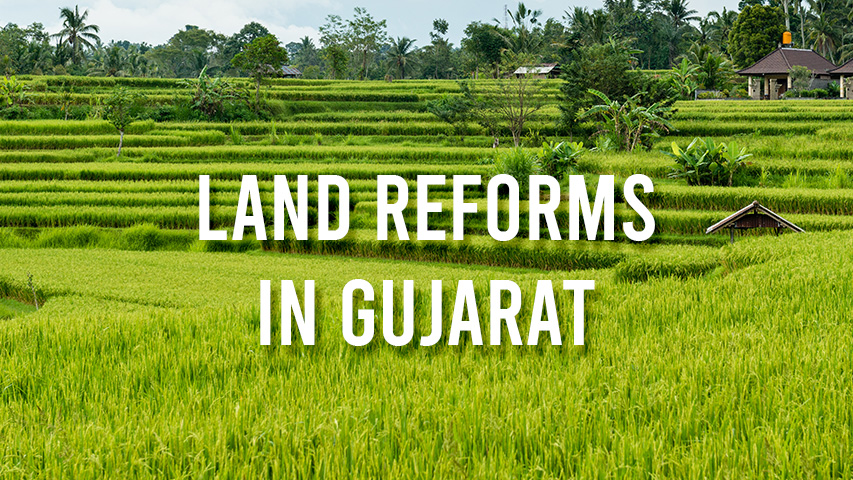
Gujarat's land reforms hold a captivating tale of transformation, reimagining the past towards a better future. Departing from traditional socio-economic structures, this article unravels the historical journey of Gujarat's land reforms, exploring the progressive policies that have reshaped the landscape and empowered communities, forging a path to prosperity.
Contents
1. Early Agrarian System in Gujarat
2. Challenges Faced
3. Impact of Land Reforms
2. Challenges Faced
3. Impact of Land Reforms
4. Winding Up Note
Early Agrarian System in GujaratThe early agrarian system in Gujarat was primarily based on subsistence farming, where farmers cultivated crops for their consumption. Land was owned and cultivated jointly by a group of people called the "khatedars". The system was characterized by cooperation, with farmers sharing resources and labour. However, this system gradually shifted towards individual ownership and commercial farming with the advent of modernization.
By the way, the agrarian system got into a revolution. It paved the way for the formation of various Acts as follows:
The Bombay Tenancy and Agricultural Lands Act, 1948
The first major land reform policy in Gujarat, introduced soon after India's independence, was the Bombay Tenancy and Agricultural Lands Act of 1948. This act aimed to protect the interests of tenant farmers, regulate rent, and provide mechanisms for acquiring ownership rights for tenants. It sought to dismantle the oppressive sharecropping system prevalent in the state.
Saurashtra Land Reforms Act of 1951
It aimed to eliminate intermediaries and give tenant farmers ownership rights. This law made it easier for landlords to transfer agricultural land to tenants while also attempting to encourage equitable land allocation.
The Gujarat Agricultural Lands Ceiling Act of 1960
The Act helped landless farmers to own the surplus land owned by landlords. The Act provides a limitation on the amount of land owned by one.
The Gujarat Agricultural Tenants Act, 1972
The Gujarat Agricultural Tenants Act, enacted in 1972, aimed to provide security to agricultural tenants and enable them to avail themselves of various legal and financial benefits. It recognized the rights of tenants to cultivate and harvest crops, protection against eviction, and access to credit facilities.
Challenges Faced
Despite the introduction of these land reform policies, Gujarat faced several challenges in their implementation. Some of the key hurdles include:
Lack of Awareness
Many landless farmers and tenants were unaware of their rights and the provisions of land reform acts. Lack of awareness prevented them from claiming their ownership rights or accessing benefits.
Resistance from Landlords
The implementation of land reforms faced resistance from powerful landlords who sought to maintain their control over land. They used legal loopholes, political clout, and intimidation tactics to evade reforms, ultimately impeding their effectiveness.
Inadequate Administrative Infrastructure
The state often lacked adequate administrative infrastructure, including courts, revenue officers, and land records, to enforce land reform acts effectively. Delayed court proceedings further hindered the timely resolution of land-related disputes.
Inaccurate Land Records
The lack of accurate land records and a comprehensive land survey impeded the identification and redistribution of surplus land. The absence of reliable data made it challenging to implement land reforms and ensure equitable distribution.
Impact of Land Reforms
Although the implementation of land reforms in Gujarat faced significant challenges, they had noticeable impacts on the agrarian structure and rural economy. Notable impacts include:
Improved Tenancy Rights
Land reforms provided security to tenants, enabling them to invest in land cultivation with the assurance of long-term occupancy. It encouraged productivity and led to better technological adoption in agriculture.
Redistribution of Land
Despite implementation challenges, land reforms facilitated the redistribution of surplus land to landless farmers. This transfer helped reduce income disparities and fostered a more equitable distribution of agricultural land.
Increase in Agricultural Productivity
Secure land tenure and ownership rights granted to tenants resulted in increased agricultural productivity. Tenants gained the motivation to invest in land improvements, adopt modern farming techniques, and increase crop yields.
Socio-Economic Transformation
Land reforms contributed to significant socio-economic transformations in rural Gujarat. They led to changes in the social structure, reduced the exploitation of tenant farmers, and improved their living conditions. The reforms also enhanced rural employment opportunities and reduced migration to urban areas.
Land reforms provided security to tenants, enabling them to invest in land cultivation with the assurance of long-term occupancy. It encouraged productivity and led to better technological adoption in agriculture.
Redistribution of Land
Despite implementation challenges, land reforms facilitated the redistribution of surplus land to landless farmers. This transfer helped reduce income disparities and fostered a more equitable distribution of agricultural land.
Increase in Agricultural Productivity
Secure land tenure and ownership rights granted to tenants resulted in increased agricultural productivity. Tenants gained the motivation to invest in land improvements, adopt modern farming techniques, and increase crop yields.
Socio-Economic Transformation
Land reforms contributed to significant socio-economic transformations in rural Gujarat. They led to changes in the social structure, reduced the exploitation of tenant farmers, and improved their living conditions. The reforms also enhanced rural employment opportunities and reduced migration to urban areas.
Winding Up Note
Land reforms have played a pivotal role in shaping Gujarat's agrarian structure and rural economy. From the initial efforts to protect tenant farmers' rights to the ambitious attempts to redistribute surplus land, Gujarat's land reform policies have had both successes and challenges. While some impacts have been positive, adequate administrative infrastructure, accurate land records, and increased awareness remain crucial for successful land reforms in the future.
